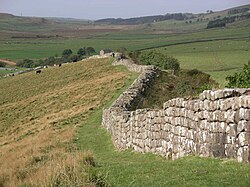英苏边界




英苏边界是英格兰和苏格兰之间的正式边界和入境标示,全长154公里,从东岸的特威德河延伸至西岸的索尔威湾。这边界是苏格兰唯一一条陆地边界,而英格兰则接邻威尔士有更长的边界。
虽然英格兰和苏格兰在很久以前已经有事实上的边界,但两国于1237年才签订《约克条约》确立[1];英格兰于1482年从苏格兰夺取卡莱尔以北和伯立克的小部分地方,称为“争议之地”。这是世界上现存古老边界之一,纵然伯立克起初仍未被英格兰吞并──该地于1885年才因议会缘故而归属诺森伯伦。
在王冠联合前几个世纪,边界的两侧都受“边界流寇”肆虐,而成为不受法律管束之地。
《联合条约》生效后,英格兰和苏格兰组成大不列颠王国,但英格兰法律和苏格兰法律仍然各自有效,因此这边界分别出两个不同司法管辖区[2]。例如,苏格兰法律规定的成年年龄是16岁,而英格兰法律是18岁,所以边界附近的英格兰人可以私奔到苏格兰,以苏格兰法律私底下结婚。
英苏的海上边界经《1999年苏格兰水域法令》修改,其领海范围是《1987年民事司法管辖权(离岸活动)法令》设立的北海油田范围以北0.09公里[3]。
边界两侧各有欢迎游客进入英格兰和苏格兰的告示牌。
历史
[编辑]
边界原野(border country),历史上称为苏格兰边(Scottish Marches)是英苏边界的两侧,按现代划分,包括英格兰的坎布里亚、达勒姆、诺森伯伦三郡,和苏格兰的邓弗里斯-加洛韦和苏格兰边疆两议会区。边界原野是山地,北邻苏格兰的南方高地,南接车韦特山。从诺曼征服英格兰起,直至苏格兰的詹姆士六世统治止,两国在边界时常冲突,因此两国君主各自委任边疆伯爵和戍边大臣守卫国土。
氏族
[编辑]16世纪的一道苏格兰议会法案谈及边界上的部落头目,17世纪末的检察大臣将“家族”(families)和“氏族”(clans)混合使用。虽然苏格兰低地的学者认为“氏族”只适用于高地人,而他们自称为“家族”,但这个分类于19世纪才出现[4]。
历史上的边界氏族包括:Armstrong、Beattie、Bannatyne、Bell、Briar、Douglas、Elliot、Graham、Hedley of Redesdale、Henderson、Home或Hume、Irvine、Jardine、Johnstone、Kerr、Little、Moffat、Nesbitt、Ogilvy、Porteous、Scott、Tweedie。
苏格兰边
[编辑]自13世纪,英格兰爱德华一世册封首名戍边大臣起,至17世纪初苏格兰的詹姆士六世(即英格兰的詹姆士一世)设立中土诸郡(Middle Shires)止,英格兰和苏格兰边界附近的土地称为“苏格兰边”。
詹姆士成为英苏两国共同国王之前,苏格兰边的家族或氏族不时按照自己的利益,而向不同的国家效忠,因此当地形成无法律状态。一个当地氏族曾盛极一时,雄据英苏之间的边界,无视英苏国家的旨令,称为“争议之地”(Debatable Lands)。
中土诸郡
[编辑]英格兰国王及苏格兰国王詹姆士颁令,将边界易名为“中土诸郡”。1605年,詹姆士成立一个委员会,由英格兰和苏格兰的十人平等组成,以便在当地建立秩序。边界流寇再无法靠越过边界来逃避法律责任[5]。简陋的边界法律废除,中土诸郡的居民明白他们需要向其他人一样遵守法律。
1603年,詹姆士国王任命第一代邓巴伯爵佐治·休姆负责在边界恢复秩序。中土诸郡的城镇设立法庭,恶名昭著的流寇被补。较棘手和低下阶层未经审讯而被处决,称为“积德堡司法”。大规则问吊屡见不鲜。
1607年,詹姆士自评中土诸郡“已成为两王国的脐地,满是文明富裕之人”。他即位十年后,中土诸郡已经受到中央的法律管辖。
1620年初期,边界地带一片和平,国王得以减少行动。
然而,联合委员会仍然运作。直至理查二世治下的1641年时,当地士绅理察·嘉咸爵士向苏格兰议会请愿,要求“平定边界的混乱局面”[6]。
流行文化
[编辑]
哈德良长城是几个世纪以来,不列颠尼亚(大概包含近代的英格兰及威尔士)与喀里多尼亚(近代的苏格兰)之间的边界。虽然不列颠尼亚的领土偶尔往北伸延至安东尼长城,但哈德良长城也常用作英苏边界的代称。哈德良长城全部位于英格兰境内,即近代边界以南。
争议领土
[编辑]纵使英苏边界于历史称得上是稳定,但也有争议,特别是争议之地和特韦德河畔伯立克。伯立克郡属于苏格兰,伯立克却属于英格兰,而伯立克至19世纪才并入英格兰的诺森伯伦[7]。支持苏格兰独立的温蒂·活迪将边界标志移到特威德河中间以示抗议[8]。
人口迁移
[编辑]坎布里亚和诺森伯伦是苏格兰境外最大的苏格兰人社群。根据2001年人口普查,坎布里亚的3.41%居民(16628人)于苏格兰出生,而诺森伯伦的3.72%居民(11435人)于苏格兰出生。英格兰全国人口的1.62%于苏格兰出生[9]。
参见
[编辑]参考资料
[编辑]- ^ Scotland Conquered, 1174-1296. The National Archives. [19 May 2012]. (原始内容存档于2021-02-24).
- ^ Collier, J.G. Conflict of Laws (PDF). Cambridge: Cambridge University Press. 2001: 6 [2014-06-21]. ISBN 0-521-78260-0. (原始内容存档 (PDF)于2011-09-27).
For the purposes of the English conflict of laws, every country in the world which is not part of England and Wales is a foreign country and its foreign laws. This means that not only totally foreign independent countries such as France or Russia... are foreign countries but also British Colonies such as the Falkland Islands. Moreover, the other parts of the United Kingdom—Scotland and Northern Ireland—are foreign countries for present purposes, as are the other British Islands, the Isle of Man, Jersey and Guernsey.
- ^ Scottish Parliament Official Report 26 April 2000[失效链接]. Retrieved 19 May 2012.
- ^ Agnew, Crispin. Clans, Families and Septs. Electric Scotland. 13 August 2001 [19 May 2012]. (原始内容存档于2021-02-11).
- ^ Act anent fugitive persones of the borders to the in countrey (1609): Forsamekle as the kingis majestie is resolved to purge the mydele schyres of this isle, heirtofoir callit the bordouris of Scotland and England, of that barbarous crueltie, wickednes and incivilitie whilk be inveterat custome almaist wes become naturall to mony of the inhabitantis thairof...(现代英语: Forasmuch as the king's majesty is resolved to purge the middle shires of this isle, heretofore called the borders of Scotland and England, of that barbarous cruelty, wickedness and incivility which by inveterate custom almost was become natural to many of the inhabitants thereof...)
- ^ 理察·嘉咸爵士的请愿内容: I am desired by Sir Richard Graham to move your majesty and this house of parliament that some present course may be taken for regulating the disorders that are now in the middle shires, this being the best time whilst the English commissioners are here that order may be given to the commissioners of both kingdoms to call the border landlords now in town to inform themselves what course has been formerly held for the suppressing of disorder and apprehending of felons and fugitives.
- ^ Kerr, Rachel. A tale of one town. BBC News. 8 October 2004 [13 April 2007]. (原始内容存档于2021-03-09).
- ^ Swapping sides: the English town that wants to be Scottish. The Independent. 13 February 2008 [31 December 2009]. (原始内容存档于6 July 2008).
It was Berwick which became the focal point for the direct action of one of the first modern Scottish nationalists, Wendy Wood in the 1950s. Controversially...she was regularly arrested for moving the border signs over the Tweed.
- ^ Neighbourhood Statistics Home Page. Office for National Statistics. [19 May 2012]. (原始内容存档于2008-12-31).
延伸阅读
[编辑]- Aird, W.M. (1997) "Northern England or southern Scotland? The Anglo-Scottish border in the eleventh and twelfth centuries and the problem of perspective" In: Appleby, J.C. and Dalton, P. (Eds) Government, religion and society in Northern England 1000-1700, Stroud: Sutton, ISBN 0-7509-1057-7, p. 27–39
